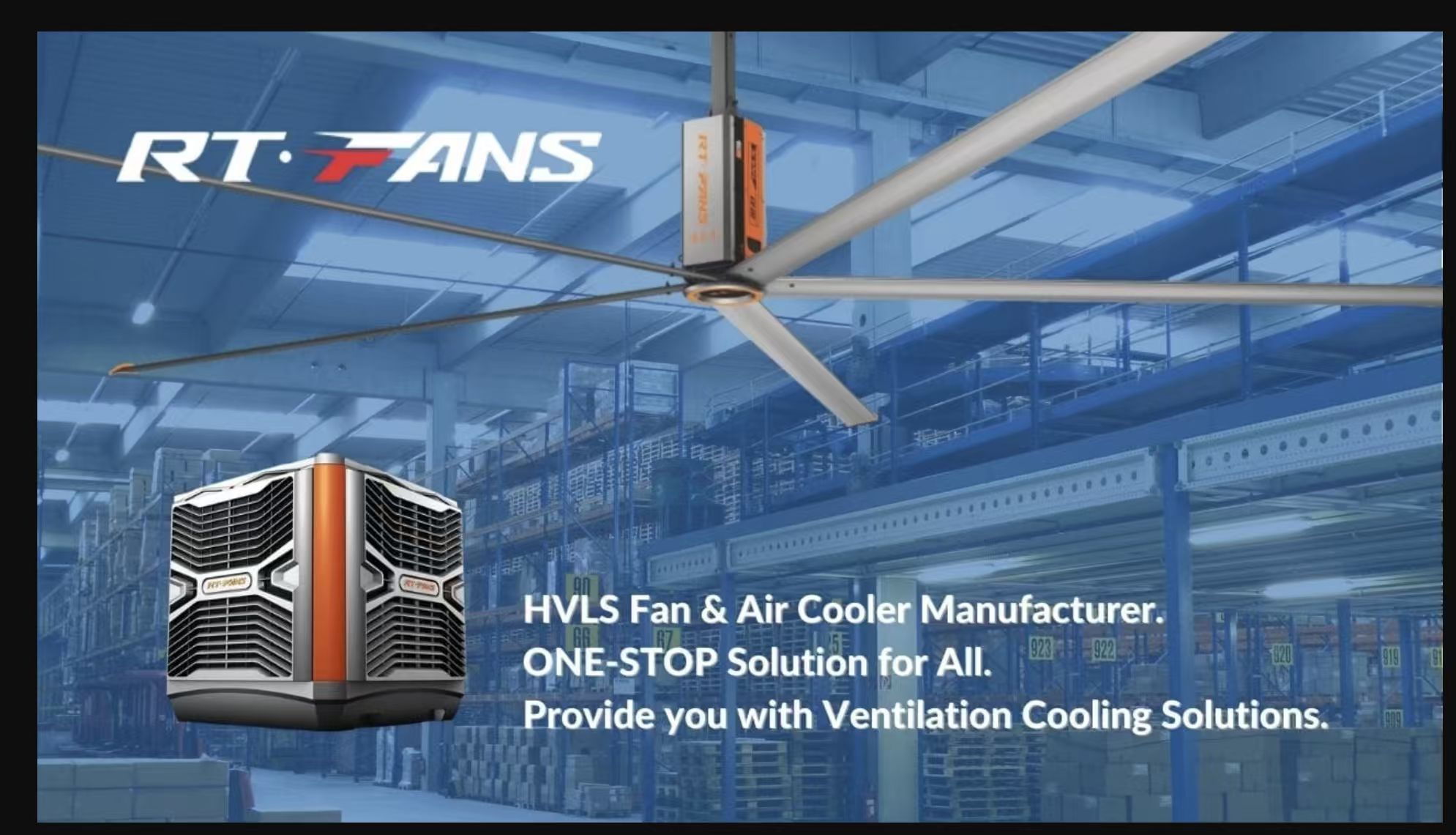The malls are vibrant zones where comfort, effectiveness, and cost containment are essential in attracting shoppers and tenants. It is highly problematic to keep these huge spaces cool, which most of the time are hundreds of thousands of square feet and have variable occupancies. The choice to install ceiling fans or chillers is not only going to impact the initial cost but also the sustainability and profitability in the long term.
Even though chillers may be required in some of the applications, industrial ceiling fans (also referred to as HVLS) may be a smarter long-term investment in shopping malls, as it is cheaper to buy, consume less energy, and are easy to maintain. They offer an 18-24 months payback with 2a 0-30 percent reduction of energy consumption, complementary work with chillers, and in line with other green provisions like LEED. We may expound on definitions, comparisons, and analyses to enable the owners of malls, facility managers, and retail developers to make informed decisions.
Defining Ceiling Fans (HVLS) and Chillers in Mall Cooling

Large-diameter ceiling fans (8-24 feet) are known as High-Volume Low-Speed (HVLS) ceiling fans used in large spaces, with speeds of up to 400,000 cubic feet per minute at low speeds (50-100 RPM) to produce diffused airflow. They offer shopping mall cooling solutions in shopping malls by destratifying the air, adding warm and cool layers, and making the air more comfortable with a wind-chill effect, best suited in atriums and common areas.
Chillers: Chillers are cooling systems that employ refrigerated water to absorb heat and circulate cooled air through the HVAC networks. They are best at delivering high-heat loads around 700 kW, like in food courts or during peak shopping times. But they are a high-investment choice because of their complexity. The critical question on the shopping mall between ceiling fans and chillers is the compromise between short-term and long-term value.
Comparing Ceiling Fans and Chillers
In order to weigh the superior long-term investment, some of the main factors are: cost of installation, power consumption, coverage ability, maintainability, area needed, ROI, and sustainability. Chillers are typically expensive in comparison to HVLS fans in malls.

Installation Cost
Ceiling Fans: HVLS fans range in price between 5,000 and 15,000 each, with installation ranging between 1,000 and 3,000, and a 100,000-square-foot mall is estimated to cost between 20,000 and 60,000 (4-6 fans). Retrofits are fast and cheap because they need very few structural adjustments.
Chillers: Same mall Chilling system costs $100,000-500,000 and up with piping, pumps, and electrical upgrades. It has an installation cost that is more expensive and can take weeks to install, and interfere with operations.
Verdict: Fans are less costly to install, suitable for low-cost, long-term investment mall ventilation.
Energy Consumption
Ceiling Fans: HVLS ceilings consume less than 1.5 kW, which saves 20-30% of HVAC load due to destratification. Superior Energy Services saves 4 percent of energy per degree of thermostat change during summer and recycles heat during winter, reducing total use by up to 35 percent in commercial buildings.
Chillers: Chillers consume 50-200 kW and above, with high continuing electricity and water (evaporative chillers incur thousands of gallons per day) costs. They are more efficient in cooling and are costly to operate.
Verdict: Fans are more energy efficient, such as when comparing ceiling fans to chillers, and the difference between the two would save a mid-sized mall between 10,000-50,000 a year.

Coverage Efficiency
Ceiling Fans: One HVLS can apply to 10,000-22,000 square feet, uniforming the airflow in atriums and walkways. They perform best in expanses that have high ceilings (20-40 feet).
Chillers: Chillers pass through whole malls through ducts, but may experience uneven cooling unless installed correctly, and whole malls may need many chillers.
Verdict: Open malls are best for cooling the mall in hybrid configurations, as fans make the best coverage of the malls.
Maintenance Needs
Ceiling fans are easy to maintain, requiring yearly cleaning of the blades and motor, and they cost about $200 to $500 per year. There is a 15-20-year lifespan and little downtime.
Chillers: They mainly need frequent refrigerant service, water treatment, and maintenance, and are priced at $5,000–$20,000/year. Sophisticated servicing may require experts, and there are increased risks of failure.
Verdict: Fans incur less maintenance, and the long-term ROI of cooling solutions for shopping centers will be cheaper to maintain.

Space Requirements
Ceiling Fans: These are installed in ceilings to create more space on the floor to sell merchandise and to shoppers.
Chillers: They take up precious real estate, and they need sole mechanical rooms, rooftops. or basements.
Verdict: Fans have space-saving characteristics, which favor mall designs.
ROI and Payback Periods
HVLS fans will break even in 18-24 months and save 20-30 of the energy, and chillers will cost 5-10 years. On a 200,000-square-foot mall, fans would save 20,000-60,000 a year; chillers, though effective, have maintenance and utilities that stretch their payback.
Sustainability
HVLS fans meet LEED requirements of energy optimization and IAQ, and minimize emissions through energy reduction. Sustainable chillers may use efficient models, though they can be water-using and use high global warming potential refrigerants.
How Ceiling Fans Complement Chillers

Ceiling fans are not necessarily meant to substitute chillers but are used as hybrid systems. In hot climates, chillers are fitted to do base cooling, and fans are fitted to distribute the air as such reduces the chiller run time by 20-30%. The HVLS mall fans are energy-saving and extend the life of the chillers.
Practical Mall Scenarios
- Small Malls: 2-4 HVLS fans can serve 50,000-square-foot malls, which are cost-effective cooling fans needed in their operations every day.
- Mega Malls: In 500,000 square-foot and above malls, fans cool the atrium in hot seasons, saving on chiller overload.
- Atrium Cooling: Open atriums have fans that draw out heat to supplement chillers during events.
FAQ: Common Questions on Mall Cooling
- Can fans replace chillers?
Yes, in mild climates to ventilate, no in hot climates to use in addition to chillers to air condition instead of ceiling fans in schools, which saves 20-30 per cent. - What’s the lifespan difference?
HVLS fans have a low maintenance life of 15-20 years; chillers have a 10-15-year life with increased maintenance. - Which saves more energy long term?
Compared with the chillers vs ceiling fans, HVAC use is saved by 20-30% with HVLS fans. - What’s the best for ROI?
HVLS fans are less expensive and more efficient, and offer a faster ROI (18-24 months) in ROI cooling solutions shopping centers.
Conclusion
Lateral ceiling fans vs. chillers in shopping malls: HVLS fans may turn into a more reasonable long-term investment, which is cheaper, consumes smaller amounts of energy, and is more sustainable. The Mall decision-makers should take the industrial ceiling fans as an alternative to or the main alternative to cut down on the cost of cooling down to make the shopping experience more comfortable. RTFANS is an experienced company; it has 20+ years and supplies the malls with customized HVLS fans. You can call us now to know more about your shopping mall cooling system, and invest in smarter ventilation today.
